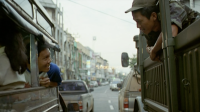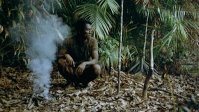Tropical Malady
05/02/2010
Thailand / 2004/ Thai
Directed by Apichatpong Weerasethakul
With Banlop Lomnoi, Sakda Kaewbuadee, Huai Dessom
 A narratively-restrained and beautifully photographed film, Tropical Malady looks at the romantic relationship that develops between Keng, a soldier in the Thai army, and Tong, a young man from the countryside, who meet in a chance encounter when Keng is traveling with his detachment. Keng accepts an offer to be transferred from the city to a nearby post, and they begin from there. They have a good time out on the town, and there is playful grappling and endearing caresses, although these may seem a bit out of context given Tong’s frustrated rural existence and Keng’s straight laced, traveling one. They respond to one another with unhurried tenderness, and the bond felt immediately between them matures among the beauty of Thailand’s northern hills.
A narratively-restrained and beautifully photographed film, Tropical Malady looks at the romantic relationship that develops between Keng, a soldier in the Thai army, and Tong, a young man from the countryside, who meet in a chance encounter when Keng is traveling with his detachment. Keng accepts an offer to be transferred from the city to a nearby post, and they begin from there. They have a good time out on the town, and there is playful grappling and endearing caresses, although these may seem a bit out of context given Tong’s frustrated rural existence and Keng’s straight laced, traveling one. They respond to one another with unhurried tenderness, and the bond felt immediately between them matures among the beauty of Thailand’s northern hills.
Keng, who comes out of a certain modernizing cultural mainstream, is the more forceful of the two. Tong, who is more elemental to the rural landscape, looking for work and drifting distractedly, responds coyly to the other man’s advances. There is something elusive about Tong, something that continually disappears from sight, and there are some quite stunned scenes as he stands aimlessly in polished shopping malls of the city. A feeling of being out of place comes up frequently. Ultimately though, the men’s personalities seem to gel quite adequately. And even in the more traditional surroundings of the countryside’s fields and temples, towards which the film gradually moves (culminating in a visit to a holy underground cave) they don’t meet with any lack of acceptance from other people. There is no forced drama – even as the circumstances begin to feel decidedly bland – only ample room for questions and subtle intimations of disparities between the two characters. All this dissolves suddenly when Keng shows up at Tong’s family’s home, finding his lover missing, and hearing reports of a tiger that has been killing cows and worrying the locals.
The film’s oneiric second half finds Keng entering the dark jungle with his rifle and walkie-talkie, evidently to find Tong. He is understandably terrified, but his terror pushes him, trembling and shaking off sweat, hunting precisely that which frightens him. This is presented in the context of a legend, which features a Khmer shaman who is able to transform himself into different creatures at will. As Keng journeys into the forest, the question arises whether he is going after his lover or the tiger, and the relationship between the soldier and the young man, which might be seen as a relationship of power, is very much turned around. Keng is alone but spied-upon, as he covers days and nights following the human footprints in the mud. He peers about at the terrifying twists of tree branches, and communes with talking animals in a setting that is at once natural and enchanted.
 While Tropical Malady’s first part, marked by a bright and almost painfully idyllic calm, is guided by the actors’ personalities and director Apichatpong’s devotion to patient naturalism, in the latter part the director drastically changes course, adding illustrations, subtitled conversations, and text explaining to the viewer what is happening. With this move into a highly effected form of presentation, he is taking control away from the more informal and incidental elements that populate the earlier scenes, and situating the story within the controlled framework of a fable. The intertextuality that can only be sensed at first is momentarily realized, made physical. A slowness pervades, and in the last hour the film’s focus becomes very lean. Much, but not all, of what proceeds from there takes place at night, as though Apichatpong were shutting out everything extraneous to tale, the back and forth between two characters – even when the large cat appears, emerging from imagination, we only see what is caught in Keng’s flashlight’s beam.
While Tropical Malady’s first part, marked by a bright and almost painfully idyllic calm, is guided by the actors’ personalities and director Apichatpong’s devotion to patient naturalism, in the latter part the director drastically changes course, adding illustrations, subtitled conversations, and text explaining to the viewer what is happening. With this move into a highly effected form of presentation, he is taking control away from the more informal and incidental elements that populate the earlier scenes, and situating the story within the controlled framework of a fable. The intertextuality that can only be sensed at first is momentarily realized, made physical. A slowness pervades, and in the last hour the film’s focus becomes very lean. Much, but not all, of what proceeds from there takes place at night, as though Apichatpong were shutting out everything extraneous to tale, the back and forth between two characters – even when the large cat appears, emerging from imagination, we only see what is caught in Keng’s flashlight’s beam.
In a literal and highly vivid way, reality and metaphor seem to be playing out, both against one another and in integrated layers. It is up for speculation whether the Keng that we are seeing in the forest is in the same role that he inhabited previously or he is being a folktale character, his moves dictated by the narrative arc of a legend. Regardless, it is apparent that he is being rendered in an altogether different light, his courtship with Tong reenacted in the illuminated forest. And we cannot know for sure if the Tong who appears in a naked and feral state, and whose lachrymose howls rise to the canopy at night, represents the tiger itself, or the spirit of the tiger as it exists within a human being. He could be animal or man, or more likely, a synthesis of the two. Like a shapeshifting beast of legend, he acts as a blank, a screen onto which one projects the attributes they associate with the tiger. For Keng, it is his most profound fears and hottest desires reified, making it known that they are, in fact, one.
Possibly the greatest film so far to come out of the Thai “new wave,” Tropical Malady feels somehow contiguous with Apichatpong’s earlier work Mysterious Object at Noon (2000) which, in a rather organic display of collective consciousness, gives the job of piecing together a story over to individuals met en route through the countryside, faithfully adapting their exquisite corpse plotline as it develops. In a similar way, this film derives its story almost from the land itself, pulling in the adventure tales of Thai author Noi Intanon, flirting with animism, lacing the scenes with the textures of daily life. Apichatpong has said in an interview that he wanted the film to exist, even as we are seeing it, as a series of memories, which explains the very fond and uncontroversial, almost trite romance that initially occurs with the two main characters. The sense of kitsch that is so powerful in the first part is treated as no less important than the oral archetypes, the sense of magic that also seems so intrinsic to the cultural landscape. The shiva linga (ceremonial phallus) that makes an appearance in the film is a crystallization of myth, minus the story, and is similarly transmitted down through history. At the beginning of the film, Keng’s father is made fun of for mentioning ghosts, but one gets the sense that everyone, at least a little bit, believes in them privately.
 The film is quite successful at dividing itself between memory and dream, and at creating the sense of timelessness that gives its literary and psychoanalytic components their respective forms – the timelessness of the village and the modern but curiously indistinct ‘between-ness’ of the city scenes. Into the shy apprehension of new love, Apichatpong incorporates Buddhism and older beliefs, and unalloyed humanism. This is all building toward an unconventional, in-film reexamination, as it were, to transform the whole story into a parable. In a relationship, one is always feeling around in the dark, and navigating parts of oneself that are little-understood. And there is a certain abstraction of the ones we love, causing them to encompass so much of what we alternately want and fear having, and to become, to some extent, the strange animal in the trees. In this sense it is easy to identify with the soldier, who pursues an object whose form he does not comprehend, and whose totality he will never be able to possess.
The film is quite successful at dividing itself between memory and dream, and at creating the sense of timelessness that gives its literary and psychoanalytic components their respective forms – the timelessness of the village and the modern but curiously indistinct ‘between-ness’ of the city scenes. Into the shy apprehension of new love, Apichatpong incorporates Buddhism and older beliefs, and unalloyed humanism. This is all building toward an unconventional, in-film reexamination, as it were, to transform the whole story into a parable. In a relationship, one is always feeling around in the dark, and navigating parts of oneself that are little-understood. And there is a certain abstraction of the ones we love, causing them to encompass so much of what we alternately want and fear having, and to become, to some extent, the strange animal in the trees. In this sense it is easy to identify with the soldier, who pursues an object whose form he does not comprehend, and whose totality he will never be able to possess.
Whatever Magical Realism is, this should be part of it! Intriguing.